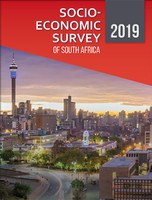
Assets and Incomes
The Assets and Incomes chapter runs to 66 pages and provides up-to-date information on earnings, expenditure, savings, investment, ownership, and poverty patterns in South Africa. The data is broken down by race, age, province, sector, occupation, and income bracket.
Business and Infrastructure
The Business and Infrastructure chapter comprises 58 pages detailing South Africa’s business environment and its structure. International indices are covered extensively to track South Africa’s global competitiveness.
The chapter also contains data on South Africa’s physical infrastructure.
Communications
The Communications chapter has 54 pages of data on the means of communication used by households and individuals. An overview of access to telecommunications such as telephones, cellphones, postal services, and the Internet is given.
Access to different modes of transport is also included. Also included is data on radio listeners, television viewers, and newspaper readers.
Crime and Security
The Crime and Security chapter consists of 90 pages on all aspects of the criminal justice system – the South African Police Service (SAPS), the courts, and prisons – as well as defense and private security.
As with preceding years, the most serious crimes are documented, while provincial breakdowns of selected crimes also feature. The section on the SAPS includes personnel data murders of police offers as well as violence and crime by the police.
Demographics
In 82 pages, the Demographics chapter illustrates the structure of South Africa’s population by race, sex, age, location, living arrangements, religion, and language.
The data shows past, current, and future trends, tracking various aspects of the human journey between birth and death. International comparisons are also included.
Economy
The Economy chapter takes up 104 pages of data on all aspects of the South African economy plus a number of comparisons with selected countries across the globe.
Education
The Education chapter is made up of 110 pages that provide an in-depth look at South Africa’s education system at all stages, ranging from preschool to tertiary level.
The detailed sub-sections provide a comprehensive picture of the resources in schools, as well as examination results and output.
Employment
In 72 pages, the Employment chapter tracks South Africa’s labour market and its participants.
It includes data on employment, unemployment, employment equity, labour shortages, and job creation. Indicators show trends over the last decade and are broken down by race, sex, province, and industry.
Health
The Health chapter comprises 120 pages of data on South Africa’s health system. It contains figures on expenditure, medical personnel, and health facilities. Also included is data on mortality, nutrition and diseases as well as HIV/AIDS-related indicators such as infection and prevalence rates, treatment and prevention and deaths.
Industrial Relations
The Industrial Relations chapter focuses, in 30 pages, on the structure of employment in South Africa, trade union coverage, and wage comparisons across different sectors. Attention is also given to strikes, their triggers and duration.
Living Conditions
The Living Conditions chapter takes up 52 pages tracking the Government’s delivery of basic services such as water, sanitation, electricity, and refuse removal.
Access to land and housing is also included. The chapter also has data on informal settlements, housing shortages, and access to affordable housing.
Politics and Government
The 46-page Politics and Government chapter provides data on South Africa’s political landscape. It details party representation at national, provincial, and local level and provides audit performance numbers on all three tiers.
The chapter also covers issues such as government performance and international indices comparing South Africa’s performance on several democracy indicators with the rest of the world.
Public Finance
The Public Finance chapter comprises 52 pages of detailed information on how much the Government receives and from whom, as well as how much it spends and on what.
Social Security
The Social Security chapter has 42 pages detailing social security expenditure and its beneficiaries.
The chapter features data on social grants, non-profit organisations, unemployment insurance, and worker compensation.